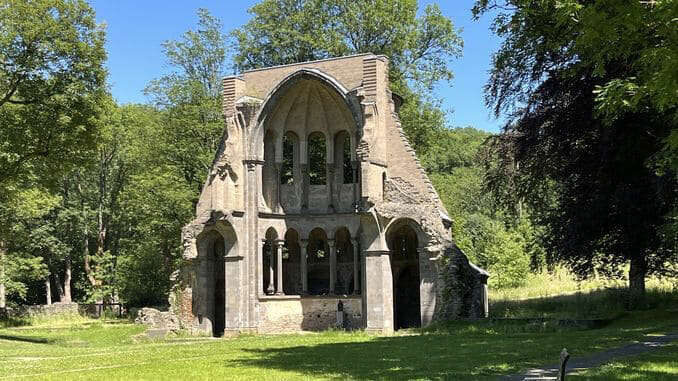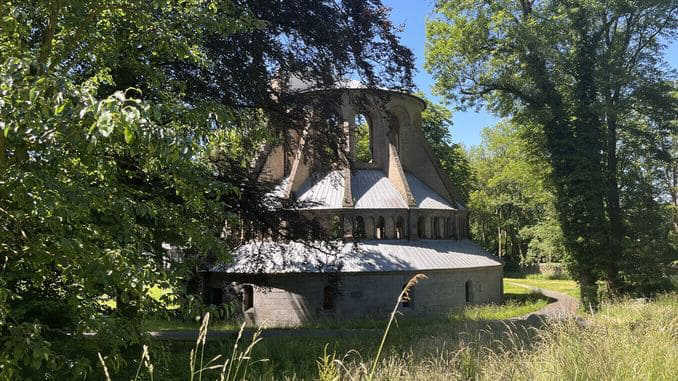
For some six centuries, Heisterbach Abbey was the religious center of our region. Only the medieval choir ruins and the tithe barn have remained.
On the way from Königswinter-Oberdollendorf to Heisterbacherrott, you will see the abbey’s baroque portal already from afar. Shortly afterwards, you see the famous choir ruin.
Since 1919, Cellites have been living at Heisterbach, and last year they could commemorate their centennial. About ten years ago, Heisterbach Abbey was at the focus of the “Regionale 2010”, a structural program of North Rhine-Westphalia. The buildings have been restored, the gardens are thriving and there are numerous information boards on historical events as well as on rare plants.
The beginnings
Let us go back to the Middle Ages at the end of the 12th century. The powerful archbishop of Cologne, Philipp von Heinsberg (1167-1190), had asked the Cistercian monastery of Himmerod to send monks to Mount Petersberg in the Siebengebirge. This was also a political coup because where the archbishop’s monks had their abbey, no count or duke could build his castle. So on 22 March 1189 twelve monks from Himmerod, led by abbot Hermann (1189-1196), arrived at Mount Petersberg. However, already in 1192 they moved down to the Heisterbach valley.
The Cistercians at Heisterbach wanted to live in seclusion and according to the Benedictine rule “ora et labora” (pray and work). Moreover, it was important to them to run their monasteries on their own. So they prayed, built their church and tilled their soil. The monks also built a hospital. Later, in 1254 Countess Mechthild of Sayn, made a big donation to the hospital.
Soon they had more than they needed for themselves and could provide for the poor in times of need. Caesarius writes about a great famine in 1198 when 1,500 people found help at the abbey’s gate.
Caesarius of Heisterbach
Now we meet the most famous monk of Heisterbach, Caesarius, who lived there from 1198 to 1240. Many of his writings have remained, and it gives great pleasure to read them. In his most famous work, the “Dialogus miraculorum”(1219/23), he described the everyday life at the abbey in miracle stories. As Caesarius was a novice master, he wrote for teaching, so there almost always is a dialogue between a monk and a novice.
Moreover, Caesarius was an important chronicler of the political events of his time. Back then, the archbishops of Colognes were mighty men, worldly and clerical rulers who possessed extensive estates and political influence. They stood in close contact with Heisterbach Abbey, so Caesarius was well-informed. For example, he reported on the war for the throne between Otto IV of Brunswick-Poitou and Philip of Swabia 1198-1208. Later, in 1225, about the violent death of archbishop Engelbert of Cologne, and another then years later he wrote the life story of Saint Elizabeth of Hungary.
The Abbey Church
Under the second abbot Gevard (1196-1209) and third abbot Heinrich I. (1208-1240) the great church came into being. The stones were mined at the nearby Stenzelberg mountain. It was one of the largest in the region back then, only the Cologne Cathedral was larger and higher.
Today we only have the ruins of the choir and drawings of what it might have looked like back then. Heisterbach is an important example of late Romanesque architecture in Germany. At the same time, the architect was familiar with the new Gothic style coming from France. Here at Heisterbach he wanted to harmonize architecture and the Cistercian ideal of simplicity.
Piety and business sense
Heisterbach was the religious center of our region and the largest landowner. The Cistercians combined piety, manifold skills and excellent business sense. They cultivated their land, farmed it, bred cattle and fish, and engaged in forestry and viticulture. As they earned more than they needed for themselves, they sold their products, earned good money and used it to finance their buildings and the purchase of even more land.
In 1312, the chapel on Mount Petersberg and the abbey church at Heisterbach became places of pilgrimage. Here, indulgences were granted, i.e., people could join a procession on a church holiday or make a pious donation and have their sins forgiven.
During the following centuries, Heisterbach Abbey lived through ups and downs. The War of Cologne (1583-88) devastated the Rhineland, and Heisterbach Abbey suffered badly. In 1650, Heisterbach received the pontificals, that is to say the abbots were almost equal to bishops. Down in Königwinter-city, they had a residence of their own, the Heisterbacher Hof. In 1750, the baroque gatehouse was built.
Secularization and demolition
For a some six centuries Heisterbach Abbey had been the religious center of our region and also the largest landowner. Then the French Revolution and Napoleon Bonaparte swept away the Old Empire. When the left bank of the Rhine fell to France in 1801, the princes who had lost territories there wanted compensations, in other words territories on the right bank. Consequently, the ecclesiastical states had to disappear from the map. By the Imperial Recess of 1803 (Reichsdeputationshauptschluss), the Archbishopric of Cologne was dissolved, the clergymen were dispossessed.
Still in the same year, the government of the Duchy of Berg abolished Heisterbach Abbey and offered the church for sale. In 1809, the French entrepreneur Piautaz purchased it, to use it as a quarry.
After the victory over Napoleon, the Rhineland fell to Prussia. Fortunately, the Prussian authorities stopped further demolition in 1818. However, the Prussian authorities noted that the locals showed only little interest in saving the abbey church.

Romanticism
In 1820, Count Wilhelm Ernst zur Lippe-Biesterfeld acquired the former abbey grounds and, in the spirit of his time, created an English landscape garden.
Then the romantics discovered Heisterbach. The poet Wolfgang Müller from Königswinter (1816-1873) took up the old legend and wrote his poem “The Monk of Heisterbach”. Painters like Wilhelm Steuerwald (1815-1871) discovered the ruined choir and the dilapidated walls in the middle of the landscape garden as a motif. Later it was a picture book motif for picture postcards.
So today we only have the choir ruin. It is a wonderful place to come to for some time of peace and contemplation. Yet, as interesting as it may be as motive for photos, it also is an “evidence of barbarity”, as Hermann José Roth says in his article in the German book “Das Siebengebirge, Natur, Landschaft, Kultur”, Köln 2002.

Be the first to comment